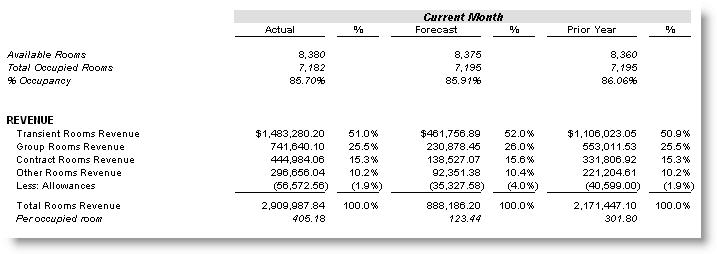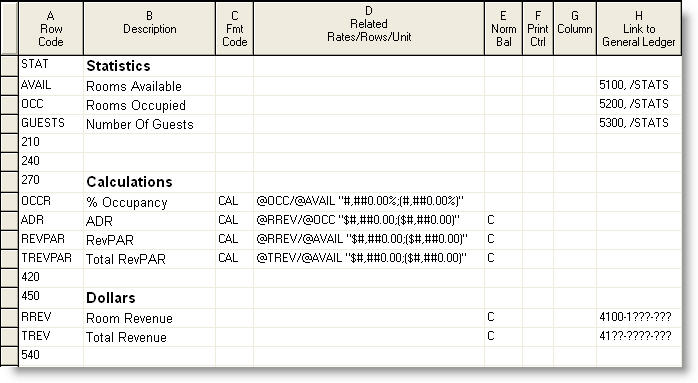I’ve designed FRx financials for a few hotels over the years—a couple quite recently.
Thought I’d take this opportunity to post on some items specific to hotels like ADR and RevPAR, but many of the concepts will be valid for anyone using FRx.
A good number of these definitions come from the Uniform System of Accounts For The Lodging Industry, the 10th Revised Edition.
I’ve divided this post into 3 sections:
- Statement of Income for a Hotel
- Hotel Operating Statements
- Hotel Operating Ratios: Average Daily Rate and RevPAR
Statement of Income for a Hotel
The hotel P&L is in essence a summarized version of the operating statements, covered later. It differs from a ‘normal’ P&L (if there is such a thing!) in that it shows departments (for instance, Rooms, Food and Beverage, Other Operated Departments, etc.) on a line by line basis, all on one page, something like this:
Revenue
Rooms
Food and Beverage
Other Operated Departments
Rentals and Other Income
Total Revenue
The coding in FRx to support the above format can be done one of two ways:
- use the entire account structure on the row, or
- use only the natural account in the row in the Link to GL, but use a tree and restrict the department by using column D in the row as follows:
The latter is much easier if your account structure is long & involved, with the added benefit of being able to add a department to the tree without many edits to the row, so it’s much easier to maintain.
Hotel Operating Statements
The Tenth Edition of the Uniform System of Accounts For The Lodging Industry specifies hotel operating statements as follows:
Summary Operating Statement
Schedule 1—Rooms
Schedule 2—Food and Beverage
Sub-schedule 2-1—Food
Sub-schedule 2-2—Beverage
(remaining omitted)
The Operating Statements lead with a summary statement followed by much more detailed operating statements for Rooms, Food and Beverage, and other departments.
The columns specified are Actual, Forecast, and Prior Year (along with percentages) for both the current period and year to date. Many hotels use Budget instead of Forecast. There is some leeway on the columns, but the revenue and expense rows must be included exactly as specified if the financials are to be “in conformity with the Uniform System“. Although—I’m told that the revenue and expense rows specified are a minimum and that you can add to them. Caveat: USALI with the 10th tried to make statements easier for financial analysts to be able to evaluate different properties by enabling better financial statement comparability, so technically you can add accounts as long as they roll up into the accounts they’ve defined.
Here’s a screenshot of a Rooms schedule as well as a link to a PDF. The report contains dummy data from FRx’s demo database Fabrikam Works, so the data isn’t confidential but an accounting eye will be able to see strange things in the data (especially in the budget). But in this case, it’s not about the data—it’s about the report format!
One thing I’ve done differently from specifications for the Rooms Schedule in the Uniform System is to add the Occupancy Rate at the top and Per Occupied Room statistics throughout. Many companies prepare a separate schedule with the Costs Per Occupied Room.
And here is a link to the full Rooms Schedule PDF: Rooms—Schedule 1
Hotel Operating Ratios: Average Daily Rate and RevPAR
Finally we get to the operating ratios of ADR Average Daily Rate and RevPAR Rooms Revenue per Available Room. All definitions again come from the Uniform System. Most hotels track the statistics used in these calculations in the GL, so that FRx can access them easily.
ADR Average Daily Rate
Average Daily Rate, or ADR, is defined as Total Rooms Revenue for a period divided by Rooms Occupied for the same period. Complimentary rooms are not included in Rooms Occupied. An example follows RevPAR.
ADR = Total Rooms Revenue / Rooms Occupied
RevPAR Rooms Revenue per Available Room
RevPAR is defined as Total Rooms Revenue divided by Rooms Available. Per the Uniform System: “…since the rooms revenue is scaled by the number of rooms at the property, it can be used as one comparison of the rooms revenue yield of a property to its competitors or comparable properties.”
RevPAR = Total Rooms Revenue / Rooms Available
What follows is an example in FRx with ADR and RevPAR calculations and some additional things like Occupancy Rate and Total RevPAR (Total RevPAR uses Total Revenue instead of Total Rooms Revenue). Couple of comments first:
- I’ve used alpha row codes because they make formulas easier to understand and review for errors. This is a great technique to use in lots of calculations (not just hotels).
- Statistics are maintained in the GL. Many companies use the 9xxx series for stats, and some use a separate ledger. If you use a separate ledger, be sure to apply the row code/book code modifier in the dropdown box in Column H in the row. This will add a ‘/Stat’ modifier behind the account depending on the name of the statistics ledger.
- I’ve added formats to the calculations: a percentage format for occupancy rate, and dollar to 2 decimal places for ADR, RevPAR and Total RevPAR.
One more important point on these statistics: normally Rooms Revenue is reported by segment (transient, group, etc), and ADR is reported on each individual segment.
This has been just a brief overview of creating hotel financials with FRx. There’s much more going on, especially with Food & Beverage. Food & Beverage departments like restaurants track covers (number eating) in order to determine the Average Check by Meal Period (breakfast, lunch, dinner). The bar tracks Number of Seats to calculate Revenue per Seat. Room Service calculates Revenue per Occupied Room. I could go on, but that’s enough for one day!



Very good stuff.
I’m in the exposition center business and I have FRx. I’ve been trying to determine how I can use FRx to add operational statistics and use to prepare forecasts.
Any suggestions would be appreciated.
I am a 35 financial veteran of the hospitality industry. My company, Hospitality Financial Advisors, LLC, does financial consulting for the hotel industry, specifically small to medium size hotel management companies.
I am also a 20 year user of Solomon and have developed numerous reports in FRx for the hotel industry.
If you would like samples of some of them, please let me know.
Miller Baird
I would love it…thanks. Jan
Jan – I was very excited to read this – I am trying to do basically the same thing, only it is for a college – fund accounting. I tried Account Attributes but that didn’t do the job completely – I think this will work but am erroring out – is there anywhere I can get more information on this particular technique to get all the parts and pieces to work together??
Thanks in advance…Cindy
Hi Millard,
If possible, I would also love to see your Hotel FRx sample reports. We are a SL, GP & NAV partner in Florida. Thank you. Angela